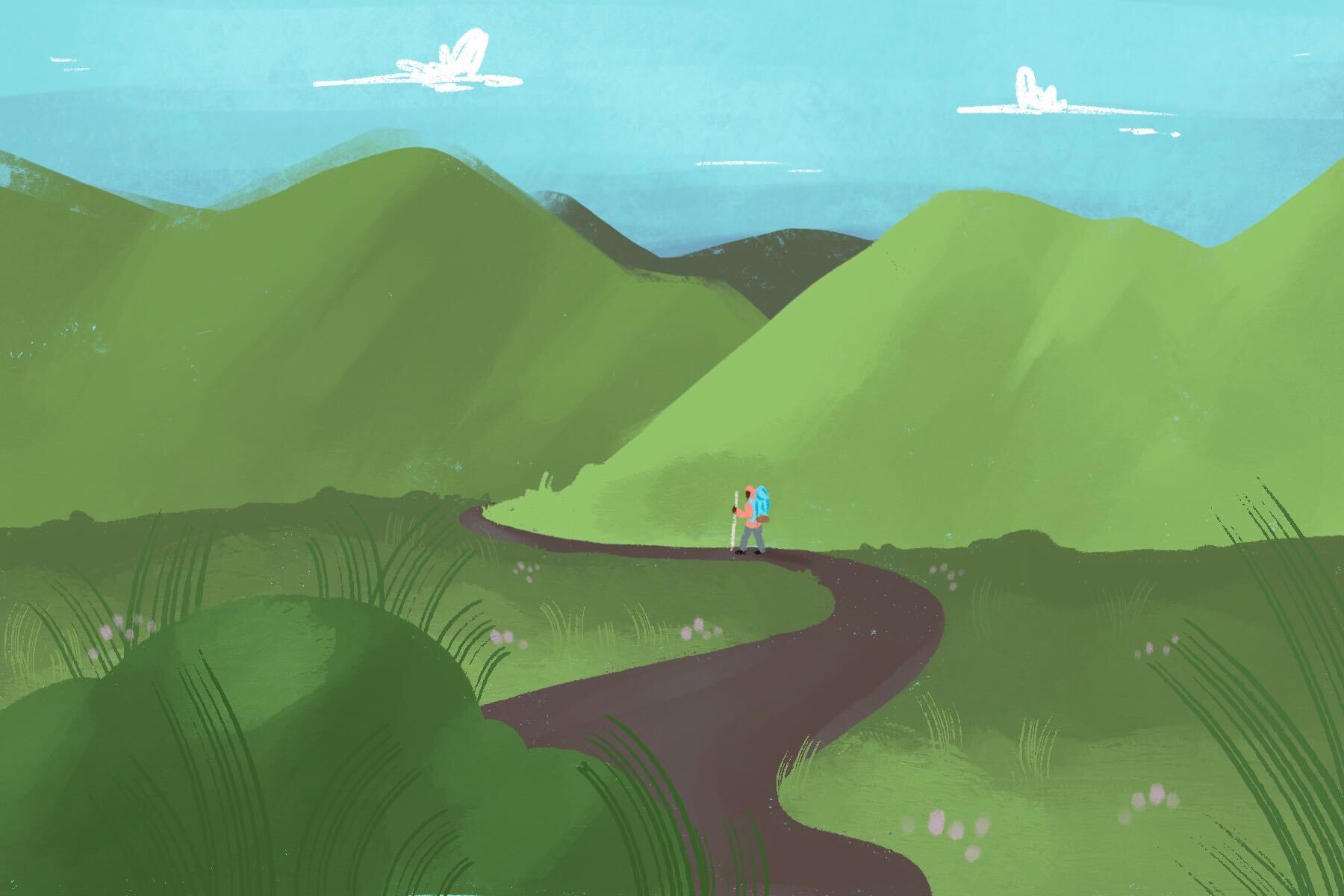My journey into the world of thru-hiking began not on a trail, but, of all places, in a bookstore. A slim green book, Bill Bryson’s “A Walk in the Woods,” captured my attention, and a quick read through the synopsis retained it. Throughout the book, Bryson recounts his attempt at hiking the Appalachian Trail.
I had heard of the Appalachian Trail and had a vague notion of it as a long hiking trail — a very long hiking trail. I devoured Bryson’s writing, clinging to every fact about the trail. Even after turning the final page, I couldn’t stop thinking about it. I found myself seeking out more information, turning to YouTube, blogs and podcasts to feed my new obsession. I discovered that the Appalachian Trail is just one part of a whole world of long-distance hiking, called thru-hiking.
Once I learned about the world of thru-hiking, there was no going back.
What Is Thru-Hiking?
According to REI, a thru-hike is “an end-to-end backpacking trip on a long-distance trail.” In simplest terms, it is hiking from one place to another for more than just a day. It often involves carrying a pack of gear and camping outdoors or in camp shelters.
In many ways, it can be compared to backpacking, but the Section Hiker website differentiates it as “a very specialized form of backpacking that’s more focused on long distance and high daily mileage in order to complete a trail within a given time frame.”
https://www.instagram.com/p/CERkRXpldiG/
That being said, thru-hiking does not include any strict rules. In fact, at the very heart of thru-hiking culture is the idea of “hike your own hike.” Quite simply, this ideology invites you to hike the way you want and to not tell others how to do so.
The Trails
Thru-hiking is about so much more than walking. The Appalachian Trail, the most famous thru-hiking trail in the United States — perhaps in the world — is the perfect example.
Running along the east coast of the United States, the Appalachian Trail guides hikers from Georgia to Maine, or Maine to Georgia for the rarer “so-bo” southbound hikers. The trail snakes through 14 states, racking up a whopping 2,193 miles. Completing it is no small feat.
Only about 25% of the hikers who attempt the trail complete it. This is after an average of five to seven months of 12 to 16 — sometimes even 20 to 25 — miles a day. Successful thru-hikers can boast that the elevation gain they conquered on the trail is equivalent to climbing Mount Everest 16 times.
Two other prominent thru-hikes are the Pacific Crest Trail and the Continental Divide Trail, which along with the Appalachian Trail, make up the United States’ Triple Crown of Hiking. The Pacific Crest Trail is a journey through stunning scenery of 2,653 miles from California to the US-Canada border.
It has risen in popularity since the release of Cheryl Strayed’s wildly popular memoir “Wild” and its movie adaptation. Least traveled of the three is the Continental Divide Trail. Its 3,100 miles along the Rocky Mountains, from Montana to New Mexico, are remote and rugged.
https://www.instagram.com/p/CErk0jQpBBU/
It is important to note that thru-hikers are not the only people who enjoy these long trails. Millions of day-hikers a year seek adventure on the very same walkways. Furthermore, thru-hiking is not limited to trails that require months on end to complete. You do not have to dedicate yourself to such a momentous task to be a thru-hiker.
There are many gorgeous paths, such as Vermont’s Long Trail and California and Nevada’s Tahoe Rim Trail that require a few weeks to complete. Thru-hiking can even fit into a weekend, as a New York Times article about a trail in New York points out.
Why Thru-Hike?
Even if you enjoy the outdoors and hiking, at this point, you may be wondering why someone would ever subject themselves to thru-hiking. Thru-hiking, no matter the trail and its length, is, without question, difficult. It is physically difficult, mentally difficult and often financially and logistically difficult.
If you are asking this question, you are not alone. Not only is this a common query for thru-hikers, but studies have also explored the motivations behind thru-hikes. Reasons range from a desire for adventure, wanting to escape the stress and boredom of daily life and proving that you can do hard things. Personally, I plan to thru-hike partly because I want to do something that is not seen as the next correct step for how life should play out.
Many people also thru-hike for the community. Although it may seem like an individual pursuit, thru-hiking is often a very social act. Thru-hikers, who lovingly refer to themselves as hiker trash, have a variety of traditions; the quintessential example is being bestowed with a trail name.
Other traditions, such as eating a half gallon of ice cream in one sitting, are specific to individual trails. The community also includes those who are not doing the hiking themselves. Trail angels are people who help out hikers. This may involve driving them from the trail into towns, providing food or water or even housing hikers for a night. Trail angels occupy a very special place in the thru-hiking community and thru-hikers’ hearts.
How to Get Started
If all of this information is speaking to you but seems unattainable, understand that thru-hiking is not as unrealistic as it may seem. You do not need to be super physically fit or a seasoned backpacker to complete a thru-hike. The first, and sometimes hardest, step is simply deciding that you are interested.
The next step is research. This will be the most enjoyable research you have experienced. Read books, watch YouTube videos and follow thru-hiker creators. There are many past and current thru-hikers sharing tips and experiences.
A few of my favorites are YouTuber Elina Osborne, whose hiking films are breathtaking, and Marie-Pier Tremblay, whose illustrations on Instagram tackle the psychological challenges of thru-hiking. I recommend these creators to everyone, even to those who do not want to thru-hike.
Of course, logistics must be considered. It is essential to think about when you would want to hike. If you plan on tackling a longer trail, you may need to take a leave of absence from work, or you may need to set aside some vacation days if you opt for a shorter trail.
Another option is section hiking, which involves hiking a long trail in parts over an extended period of time, sometimes even a lifetime. I plan on hiking the Appalachian Trail a year after I graduate college. Setting aside a time leaves ample space for further planning, gathering gear and of course, getting excited.
Perhaps you too have been bitten by the thru-hiking bug. You may try to drown it out, to tell yourself a thru-hike isn’t reasonable. But the little whisper in the back of your head, that thirst for an adventure won’t go away that easily. Don’t try to shut it up. Listening may be the best decision of your life. If you plan on hiking the Appalachian Trail in 2023, I’ll see you there!

















